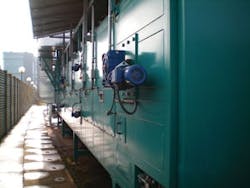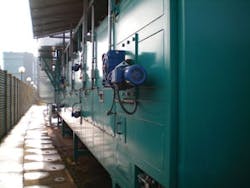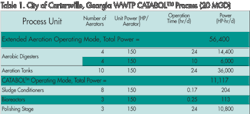Treatment Plant Upgrade Yields Energy Savings, Biosolids Reduction
By James Stafford, J. Sidney Forsyth, Rocco M. Palazzolo, and Boris M. Khudenko
The City of Cartersville, GA, undertook a project to modify its extended aeration activated sludge municipal wastewater treatment plant to allow use of a new treatment system. In addition to increased treatment capacity, the process modification improved treatment performance and process stability and reduced operating costs.
Hydrocyclones are used to remove inert solids from the system. Approximately 20,000 pounds of this dewatered material is removed to a landfill every other week.
Prior to the project, the treatment plant used aerobic sludge digestion, belt filter press sludge dewatering and land application of biosolids. The operation and maintenance costs at the Cartersville Wastewater Treatment Plant were $1.9 million per year.
The new system features the CatabolTM Process developed and patented by Boris M. Khudenko, PhD, PE. It uses combined methanogenic-aerobic sludge and relies primarily on the anaerobic conversion of organics with biological-abiotic removal of nutrients, recalcitrant organics, biosolids destruction, and alkalinity and pH control. Operation of this plant has produced a high quality effluent with increased process stability, while reducing the energy requirement for aeration by 80% and waste biosolids production by at least 60%. The operation and maintenance costs have been reduced by approximately $550,000 per year.
Process Description
The Catabol system consists of preliminary treatment, anaerobic bioreactors, aerobic polishing tank, standard clarifiers, chlorination, de-chlorination, screens and hydrocyclones, and anaerobic sludge conditioners.
The system used at the City of Cartersville's water pollution control plant delivers the highly methanogenic organisms propagated in anaerobic conditioners into the wastewater treatment train, thereby creating an almost endlessly recyclable sludge with very low associated operating costs, no odor, and a minimal biosolids yield. This is the first municipal wastewater treatment facility to use this process.
In typical wastewater treatment processes, whether with aerobic, anaerobic, or other sludge stabilization methods, the sludge handling portion of the plant is used as the end process for the waste treatment train. With the Catabol operating system the sludge conditioners cultivate and store methanogenic organisms that are delivered to the influent waste stream, just as return activated sludge is returned to the aeration basin in a conventional treatment process. This effectively puts the methanogenic biosolids handling step at the front of the treatment process.
The sludge conditioners are very similar to standard anaerobic digesters; they stabilize the sludge in the absence of dissolved oxygen. There are, however, significant differences when operating these tanks in conjunction with the system.
First, while standard covered anaerobic digesters may be used in the Catabol process for methane collection and utilization, they are not necessary for odor control. The hydrogen sulfide odor normally associated with anaerobic digestion is not produced in this system because of the de-selection of the odor generating bacteria by the overwhelming population of methanogens in the sludge which out-compete the sulfite reducing bacteria for food. The Cartersville plant retrofitted standard open top aerobic digesters to open top anaerobic conditioners with no resulting odor.
Secondly, in typical digestion the effluent line of the digester train leads only to ultimate disposal, whether dewatered or as a liquid. With the Cartersville system the primary discharge line from the conditioner train leads back to the head works of the plant to be used in the initial uptake of influent biochemical oxygen demand (BOD).
Since methanogenic organisms in a biomass generate only about one-sixth the amount of byproduct sludge as do aerobic organisms, the sludge yield for this type of treatment is much lower and does not require continuous disposal.
This sludge, after intimate mixing with the influent waste stream, accumulates in the plant anaerobic bioreactor, where it is pumped back to the sludge conditioners for stabilization. Here the by-products of digestion (methane, carbon dioxide, and hydrogen) are released and the "hungry" methanogens are recycled back to the plant influent at a measured rate.
A third major difference is the very long solids retention time in the plant. Consequently a high concentration of inert or nonbiodegradable solids is retained in the system. To remove these solids a portion of the sludge pumped from the bioreactors to the conditioners is sent through a system of hydrocyclones. The hydrocyclones produce 45% inert material which is dewatered further in a specially designed dumpster. These solids are typically 75% inert, and approximately 20,000 pounds of this material is removed to the landfill every other week.
The remaining treatment steps in the plant work similar to those of a conventional activated sludge plant. However, after treatment in the bioreactors the reduced BOD of the wastewater allows the aerated polishing tank and conventional secondary clarifiers to perform secondary treatment with a much lower energy input and very minimal sludge yield as compared to typical activated sludge processes.
Energy Savings
The most significant energy reduction at the Cartersville plant is due to reduced operation of the aerators in the aeration tanks (converted to bioreactors and polishing stages) and aerobic digesters (converted to sludge conditioners) following conversion to the new system. The power requirement for aeration during operation in the extended aeration mode was 56,400 HP-hr/d. The power requirement for aeration in the process units while using the Catabol process is 11,117 HP-hr/d which is an 80% reduction in electrical consumption for aeration as presented in Table 1.
The plant-wide reduction in annual electrical use of 6,755,400 KWh/year (55%) provides a savings of $381,264 savings per year (51% of O&M). Approximately 25% of cost reduction is due to lower peak demand charges, 75% of savings is due to reduced consumption.
Sludge Reduction
The wastewater treatment plant was operated in the extended aeration mode in 2003. A total of 450,000 dry lb/month of aerobically digested, dewatered sludge was disposed of by land application. The average number of days the belt filter presses operated in 2003 was 16 days/month. In 2009 with operation in the Catabol mode, the total sludge disposed was reduced by approximately 50% to 218,000 dry lb/month. The average number of days the belt filter presses were operated in 2009 was reduced to 7 days/month.
The inert solids discharged to the Cartersville WPCP in 2009 by a major industry increased by an average of 118,000 dry lb/month compared to 2003 due to their inability to remove these solids on site. These inert solids were not degraded in the treatment system and were disposed of with the biosolids. With these solids subtracted from the total sludge disposed, the net biosolids in 2009 is estimated to be approximately 100,000 lb/month, giving a biosolids reduction of approximately 78% compared to extended aeration operation.
Summary
The treatment plant maintained a high quality effluent during operation in the Catabol mode with an energy reduction of approximately 55% as shown above and a 75% reduction in biosolids production. O&M costs at the Cartersville, Georgia plant have been reduced by $550,000 per year, or about 30% of the total operating cost. This process is very stable and the methanogens can be stored without food for years and still remain active.
The city is currently evaluating the next step of optimizing resources by covering the sludge conditioners and capturing the methane generated there to clean and use as a fuel in the plant or, possibly sell to the local natural gas utility. WW
About the Authors:James Stafford is Director Cartersville Water Department. J. Sidney Forsyth is Operations Manager for the Cartersville Water Department. Rocco M. Palazzolo, P.E. and Boris M. Khudenko, Ph.D., P.E., are both with Khudenko Engineering Inc.
More WaterWorld Current Issue Articles
More WaterWorld Archives Issue Articles




